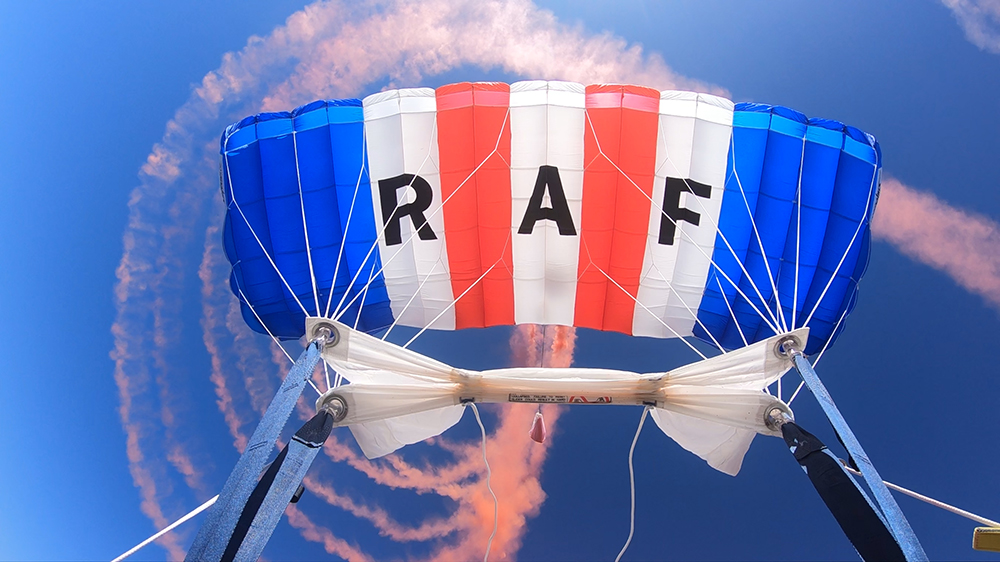
2024 Team Members
All RAF Falcons Parachute Display Team Members are drawn from the personnel of Airborne Delivery Wing, based at RAF Brize Norton.
Each RAF Falcons Team member undertakes continual advanced training as a Parachute Jumping Instructor in preparation for future employment. Once they have finished their three-year tour with the team they will return to their Royal Air Force duties, in support of the Parachute Regiment, the Royal Marines and other specialist units.
Training
Prior to the start of the display season the RAF Falcons leave the inclement weather of the UK behind them and head for California to complete the majority of their display parachute training. On their return to the UK the Team undertake a further period of training adjusting to the UK’s unpredictable weather conditions.
.jpg)
The aim of the training is to teach the first year team members all aspects of display parachuting and integrate all the RAF Falcon members into a close-knit team, ready for the forthcoming season. Although experienced instructors, display parachuting is alien to the new team members, offering them many new challenges. The training consists of numerous modules which include various written and practical assessments and the training is both mentally and physically demanding.
The Team complete 8 descents per day and pack their own parachutes. Due to the progressive nature of the training, the Team is initially broken down into small groups, consisting of varying experience levels. Group sizes are gradually increased, culminating in the full Team performing high, mid and low altitude displays. The finishing touches are then introduced with smokes and life jackets being worn and advanced manoeuvres performed.
Freefall training
Since 2012, the RAF Falcons have embarked upon pre-season exercises that focus strongly on close proximity free fall flying. Team members receive a period of prolonged exposure to advanced skydiving techniques. In addition to preparing them for displays, the aim of the training is for each team member to attain the coveted Military Free Fall Instructor qualification. By doing this they gain the knowledge required to provide our airborne soldiers with the best instructors.
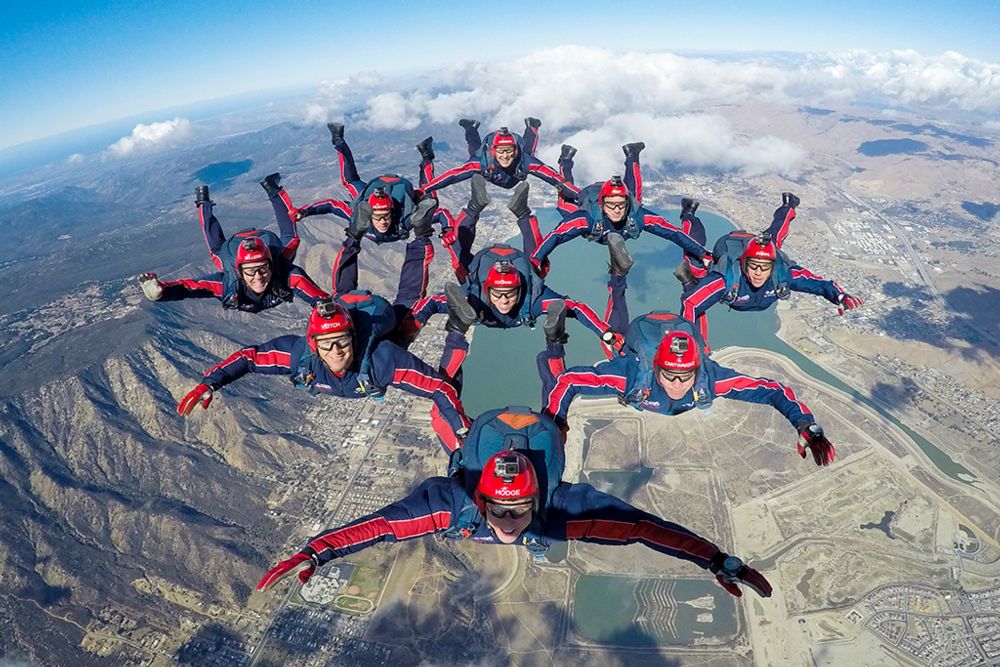
The team undertake a variety of skydives, included in this is ‘dirt diving’, a technique for rehearsing a skydive on the ground before performing it in the air. Full video debriefing allows the team members to assess their performance and improve highlighted areas. This process not only helps develop their skydiving skills but also allows them to identify areas of weakness and improve on them. These are skills fundamental to being good free fall instructors.
Wind Tunnel
The wind tunnel at Bodyflight, Bedford has become one of the RAF Falcons major training facilities over the last three years. The wind tunnel is essentially a concrete structure with air blown from bottom to top at various speeds to enable the training of all different skydiving techniques.
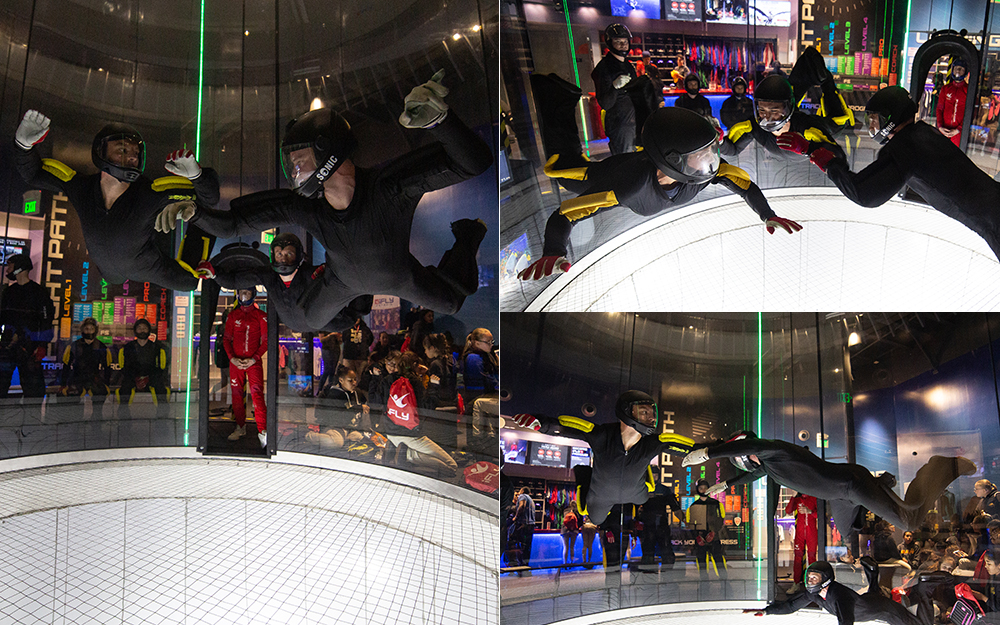
First Year Falcons
The RAF Falcons first year members enhance their basic skydiving techniques by planning and completing 4-way formation skydives. These skills are a vital basis for the individual to progress to become a Military Free Fall Instructor (MFFI) by the end of their 3rd year. There will also be an introduction to back flying and tunnel walking.
Second Year Falcons
The RAF Falcons 2nd year members enhance their 4-way formation skydiving. Once they have achieved a satisfactory level, they will be afforded the opportunity to move on to ‘beat up’ training and simulated student work needed to learn the skills to be an in-air instructor of a first time skydiver. They also attempt to progress from back flying to sit flying which allows them to follow advanced military parachutists at high speed with relative ease.
Third Year Falcons
The 3rd Year Falcons consolidate their back and sit flying skills learnt the previous year but mainly concentrate on teaching beginner and intermediate level skydiving troops in the tunnel. This will prepare them for their future postings after the RAF Falcons. All the training is facilitated by the RAF Falcons Team Coach and other advanced parachutists from within Airborne Delivery Wing. Each individual will have extensively utilised the wind tunnel in order to become a MFFI.
How to become an RAF Falcon
As with any career in the RAF, the journey begins by visiting your local Armed Forces Careers Office, located all over the country. Further information can be found at recruitment.raf.mod.uk.
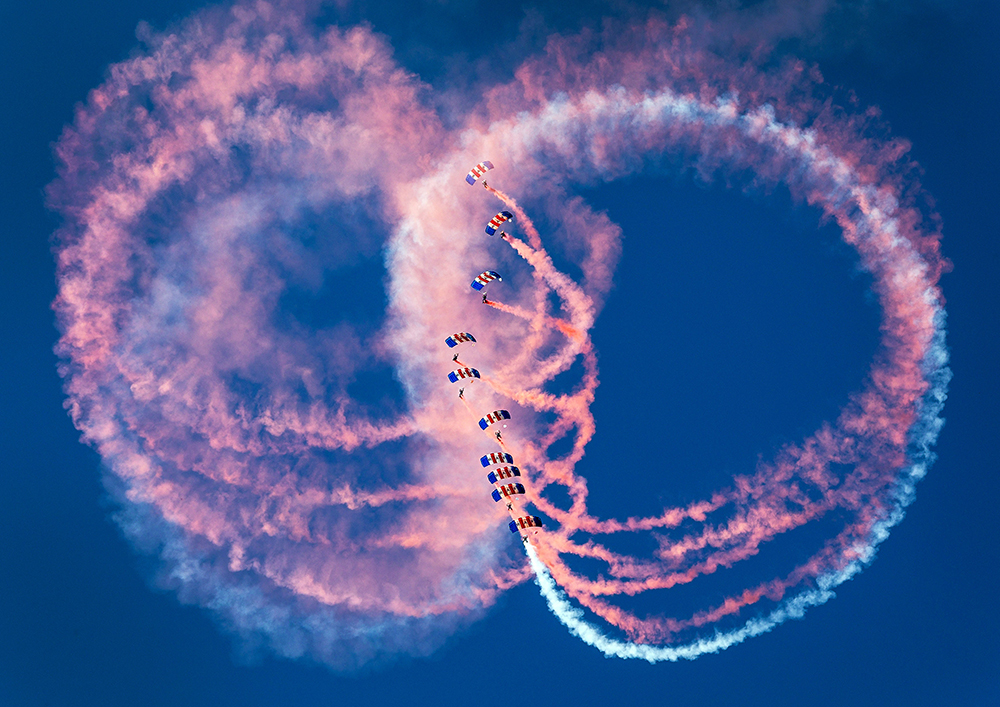
Once a meeting has been set up with the RAF representative at the Careers Office you will be assessed for suitability for service life before completing an aptitude test. In order to become an RAF Falcon you must apply to join the RAF as either a Physical Training Instructor (PTI) or Personnel Officer (Pers).
After submitting a successful application, candidates attend a two day specialist interview at the RAF School of Physical Training based at Defence College of Aeronautical Engineering (DCAE), RAF Cosford.
On successful completion of the interviews all applicants then attend Basic Military Training. PTIs undertake their training at RAF Halton (10 weeks) and Personnel Officers at RAF College Cranwell (9 months.) Physical fitness, general service knowledge and initial ground defence training are some of the elements covered.
After graduating from basic training, all PTIs attend Specialist Trade Training at the RAF School of Physical Training. The PTI course consists of several modules including anatomy and physiology, coaching and teaching techniques. During the teaching phase, PTIs gain the Personal Trainer Award Level 3 and obtain the National Pool Lifeguard qualification.
After completing Trade Training, PTIs will complete at least one tour of duty at a station gymnasium, developing their instructional and leadership skills. All PTIs and Pers Officers may be selected for Parachute Jump Instructor (PJI) duties at Airborne Delivery Wing, RAF Brize Norton.
The PJI Course begins with a 4 week Basic Military Parachuting Course, working alongside other airborne units such as the Parachute Regiment and Royal Marines. Following this, the prospective PJIs then undergo an intensive training package consisting of jumping several static line parachutes and learning to teach basic static line parachuting. On completion of the PJI Course, candidates are awarded the coveted PJI Brevet.
After serving at least one tour teaching static line parachuting, PJIs are the considered for selection in display parachuting duties. The selection for such duties consists of a continuous assessment throughout the year. Every jump is critiqued and the individual debriefed on their free fall skills, canopy control and accuracy on landing. Candidates must also complete the High Altitude Parachutist Course before the final selection phase.
Prior to selection, candidates must also demonstrate teamwork, leadership and the potential to become military free fall instructors. Once selected, new Team members complete a Display Parachutist Course, usually in California, USA. The course consists of up to 140 descents. They will learn and refine the skills required to become a fully qualified RAF Falcon.
Life After the RAF Falcons
In addition to the busy display schedule, team members also receive advanced coaching and tuition to enable them to become Military Freefall Instructors.
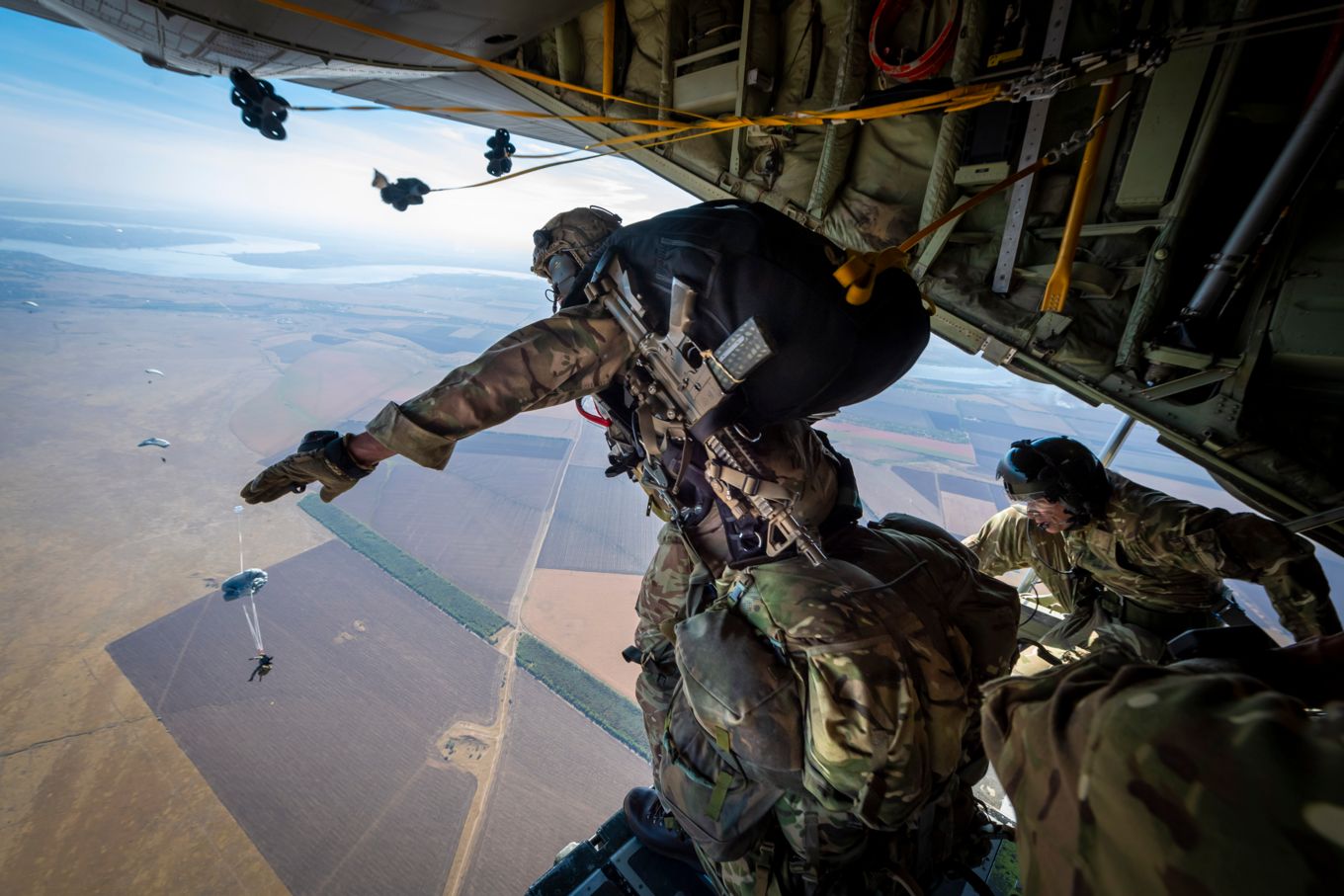
Parachute Training School (PTS)
After completing a tour with the RAF Falcons, the Parachute Jumping Instructor (PJI) may be selected to serve on PTS.
The requirement for PTS is to instruct airborne soldiers undertaking the Basic Parachute Course as beginners and keep those already trained to a high level of readiness to parachute. This role also involves dispatching parachutists at very low level using the Low Level Parachute in the static line mode or from an extremely high level using the BT80 Multi Mission System in both static line and freefall modes. Military tandem parachuting is a specialist method of insertion used by the Pathfinders, and the PJI is trained to support them. Furthermore, the Royal Navy drops a variety of boats from the back of aircraft followed by specialists, all dispatched by the PJI.
Joint Air Delivery Test & Evaluation Unit (JADTEU)
JADTEU is a Tri-Service unit based at RAF Brize Norton. The unit is primarily responsible for the test and evaluation of everything that is carried in or under an aircraft and anything that is delivered from an aircraft by parachute (stores and personnel).
The Parachute Test Team (PTT) is responsible for the personnel parachute element of this task. PTT is commanded by a Squadron Leader (Sqn Ldr) PJI and consists of several other PJIs as well as a number of support elements including a Senior Non-Commissioned Officer (SNCO) Survival Equipment Fitter, a SNCO from the Parachute Regiment and a SNCO Army Medic. PTT rigorously test, develop and operationally evaluate all parachute systems and parachute ancillary equipment prior to its introduction into Service, ensuring that the UK ‘s Airborne Forces receive equipment is fit for purpose with drills and procedures for its safe employment in both training and on operations as quickly as possible. The members of PTT are some of the most experienced and highly qualified PJIs in the Service.
Instructor Training Flight (ITF)
The primary role of ITF is to instruct the PJI training course which qualifies selected Personnel Officers and Physical Training Instructors as well as Foreign and Commonwealth Forces in the basics of static line parachuting jumping instruction. Additionally, ITF is responsible for the professional development training of qualified PJIs. Furthermore, ITF is responsible for the training of Army Parachute Jumping Instructors, who are selected Army personnel required to assist the RAF PJI’s with basic low level parachuting instructional duties.
History
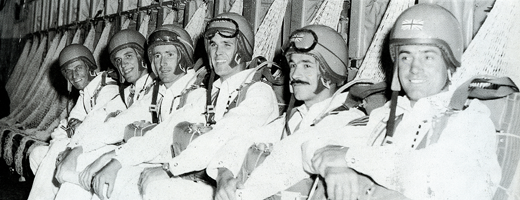
Pioneers of 1961
The RAF Falcons have enjoyed a long and distinguished history as one of the premier display teams in the world. The team was originally formed in 1961 by six instructors from the Parachute Training School at RAF Abingdon: Flight Lieutenants Hearn and Thirtle, FS Moloney, Sergeants Peacock, Robertson and Mcloughlin.
The team were nicknamed ‘The Big 6’ as most of the members were shorter than 5 ft 6 in! The team trialled different ways of exiting the aircraft, initially jumping from the Blackburn, Beverley and Hastings aircraft. ‘The Big 6’ made their debut display at the Farnborough Air Show in 1961.
The displays performed by ‘The Big 6’ made them an immediate hit with the public. The demands became so overwhelming that in 1965 it was decided to increase the size of the team to twelve men. At this point the team was renamed the RAF Falcons, taking the name from a bird of prey which represented their displays; swift, swooping, elegant and aerobatic in flight. Within two years of the birth of the Falcons they were setting new records and introducing many exciting innovations into the sport. At the end of the 1966 season the Team started to experiment with formation skydiving. The same year saw the introduction of the helmet mounted camera to film this in-air work. Throughout the 1960s and early 1970s the Falcons continued to break records and performed in front of Her Majesty the Queen during the RAF 50th Anniversary display at RAF Abingdon, their home station. They have since performed many times for the royal family and for numerous heads of state worldwide.
Display techniques
Display techniques have changed dramatically since the early years of ‘The Big 6’. Progression saw the introduction of a close non-contact stack with each parachutist trailing coloured smoke and the coach carrying a flag into very challenging arenas. The changes to the display have reflected the developments in parachuting. In 1965 the RAF Falcons flew the round ‘Para Commander’ parachute which was used until the inception of the highly manoeuvrable square parachutes in 1978.
The first square canopy used was the ‘Strato Cloud Ram Air Parachute’. This was subsequently replaced by the GQ236, then the ‘XL Cloud’ in 1985 before the ‘Fury’ parachute was introduced. This has been superseded by the state of the art ‘Performance Design ‘Silhouette’ Canopy, the canopy currently used by the team.
The aims of the Falcons have also changed enormously over the decades. In addition to completing displays, there is a requirement for team members to qualify as Military Free Fall Instructors and High Altitude Instructors by the end of their three year tour. During their time on the Falcons, each team member will accumulate 1000 jumps, many of which are on training detachments worldwide.
The RAF Falcons have been privileged enough to perform in front of millions of people throughout their history. It is a great honour to be an RAF Falcon displaying all over the country, demonstrating skills and promoting the RAF to the general public. By providing their own unique freefall display, the Falcons remain one of the world’s leading free fall display teams and continue to be a major attraction wherever they perform.
The ‘Falcon Stack’ has recently been changed in 2021 to showcase a new and different display. The fine-tuned and advanced canopy handling techniques that show this are taught whilst training overseas on Exercise. The Heart, Criss Cross-Carousel, Snakes & Ducks and Sabre Chase are all new features to keep your eye out for in coming displays.
For more historical information regarding the RAF Falcons please visit ptsheritage.com







